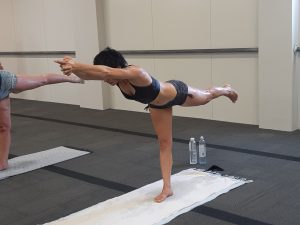According to Dr Michael Mosley our balance is far worse than it used to be. Where once we’d spend much of the day moving about, nowadays many of us sit staring at computer screens. As working from home increases, we may not walk further than from the kitchen to the spare room to get to work.
This more sedentary lifestyle affects our balance skills and comes at a cost. After car crashes the biggest cause of accidental deaths worldwide is through falls – caused by a failure of balance.
Balance is an incredible feat of coordination and it needs to be practised!
In yoga we recognise how important building balance is. You stand on one leg* in more than half of the standing poses in Bikram Yoga. Eagle, standing head to knee, standing bow pulling, balancing stick, tree pose and toe stand.
So what is happening when you try to stand on one leg in a posture?
You’re in Balancing Stick. While your mind is as quiet and calm as a lake on a windstill day😊 your brain is performing a remarkable amount of coordination. It integrates signals coming from the fluid in your inner ears, visual cues from eyes, and even feedback from your joints and muscles.
Signals from your eyes play a big role in maintaining your balance, this is why we use the mirror to find a point of focus.
Each time you stand on one leg it’s your chance to recalibrate your brain and fight the aging process.
As we age the balance structures in your inner ear begin to deteriorate – the number of hair cells in your inner ear decrease, and even the amount of blood flow you get into your inner ear begins to change. But there are still things you can do to overcome this inevitable decline, and it’s all to do with making yourself feel wobbly.
Relieved? Why Wobbling is OK
As you fight to be still and stand on one leg, your brain is making new nerve connections to enable the balance to happen. The famous neural plasticity. It is now known that there are activities which will maximise our brain’s plasticity and therefore continue the development of neural connections (synapses) which will effectlvely, lessen the aging process.
Embrace the Wobble
So don’t worry if you wobble in a posture. Wobbling is forming new connections and strengthening the coordination between your ears, eyes, joints and muscles. Sensors in all our joints and muscles keep sending feedback to the brain so it can learn how best to keep you upright. Balance regularly on one leg and you’ll find that your balance improves surprisingly quickly.
Other balancing Acts
It may not have occurred to you that when you’re walking 40% of the walk is spent on just one leg. Unless you are under 3 years old (in which case good on you for your advanced reading skills) we assume you are pretty accomplished at walking. So keep walking because it is a balancing act! Again, as we get into our cars more, by default we walk less.
Unless you are under 3 years old (in which case good on you for your advanced reading skills) we assume you are pretty accomplished at walking. So keep walking because it is a balancing act! Again, as we get into our cars more, by default we walk less.
Other Reasons to Balance
It will help everything else you do in your life – sports, activities, walking, picking up your child/grandchild, opening the car door while holding 3 bags of shopping and a coffee.
Builds a confident core – core is more than tummy muscles, it’s all the muscles that control the pelvis and the spine. A functioning and strong core will also improve body alignment.
So when you hear the teacher say, if you fall out, try again. This is why!
*Rather than balancing think of it as standing on one leg. The instant we hear the word “balance” we imagine falling over. So, it’s simply standing on one leg. Easy. Right?!

